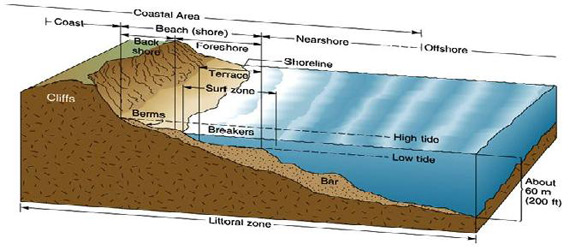The Atlantic Ocean, relentlessly pounding the shoreline of Long Beach Island, boasts a number of different habitats right coast. These habitats are an important source of food both for ocean dwelling creatures and many non-marine animals. If we brake the shore and the water leading away from it into zones we can begin to understand both large and small differences between these habitats. Just like terrestrial habitats, marine environments vary in conditions that influence what plants and animals are able to live and thrive in each location.
Lets begin at a place that is familiar to us, since it is still on land.
The Beach
When we sit on the beach we don't typically think of this zone as being a true ocean environment. The next time you are at the beach stand at the edge of the water and look away from the ocean towards the back of the beach. If there are dunes, you can now easily see the full reach of the ocean's waters. The reason the beach changes at the edge of the dune is because the waves have managed to wash back to the dune edge, at least at some point in the recent past. It may have been the last monthly spring tide or it could have been over the course of high tides during the winter months. Regardless of when this last occurred the beach is, in some sense, under the direct influence of the ocean.
If the beach is not heavily used when you are there, say it is the offseason, or you are in a protected natural area then you may see a line of wrack that reaches up to some point along the beach. The wrack line is usually shells, debri and perhaps seaweed that is stretched along an uneven line parallel to the shore. This line marks the extant of the last high tide or maybe a high tide or two before the last. If you are standing on the beach between the waters edge and the wrackline, you are on land that is regularly washed over by ocean waves.
Intertidal Zone
This is the portion of the coastline that is exposed to the inshore wave action. Parts of the intertidal are exposed, or above water, at least part of the time. Marine biologists break the intertidal zone into distinct regions: upper, middle and lower. The beach is technically part of the intertidal since it gets washed by the waves during high tides. This is what was just discussed regarding the beach.
Few organisms make their home here. Many scavengers regularly visit, often to pick through the wrack that washes ashore with each new tide. The upper intertidal zone is a rough place. Salt water comes and goes from this area and the wind can blow strongly off the ocean when it is exposed. The sun beating down on the open sand can create high temperatures that are widely divergent from the lower temperatures at night or brought from the washing over of the ocean during a high tide.
You can stand on the edge of the ocean's further down the beach than you can during a high tide. This zone is the middle intertidal and it is regularly exposed and inundated with the rising and falling tides.
The lower intertidal includes areas that are only exposed during the lowest tides and areas that are always inundated but are none the less directly involved in the surf and wave actions that take place nearshore.
Different organisms use portions of the high and middle littoral habitat for feeding but few live here all their lives. The low intertidal is more heavily used than the other tidal areas by a more diverse group of organisms. This will soon be discussed in greater detail.

In this diagram the intertidal would be in the area that is called the surf zone.
